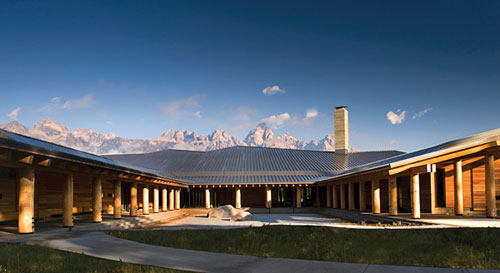Getting to Green: Life Cycle Analysis plus Forest Certification Give Western Redcedar High Marks in Sustainability
Increasing Validity of Comparison Analysis
There were many challenges involved in leveling the LCA comparison analyses of different products. According to FPInnovation's O'Connor, to increase the validity of the comparisons, a sensitivity analysis was performed to test the influence of various assumptions and to provide "what-if" scenarios that might change the relative performance of the decking alternatives. "When comparing one product to another it is particularly important to do a peer review, to make sure you're coming from a neutral place," says O'Connor. "You want to give the other products the benefit of the doubt to the extent possible and present the information in a way that is credible and transparent."
Specifically, in the western redcedar LCA, additional burdens were added to the cedar base case in the form of a regular regime of staining and board replacement, while removing environmental liabilities from the WPC scenarios, notably using a higher wood-to-plastic ratio in the formulation and shifting to partial biomass for production energy. Yet even in this cedar-worst-case comparison to WPC best-case, western redcedar still outperformed WPC alternates, although the WPC profiles are improved with those two changes. The LCA also compared the two WPC formulations finding that, as might be expected, manufacturing this product with recycled plastic substantially improves the environmental profile over a virgin plastic composite.
The analysis also found environmental burdens with western redcedar siding that were not experienced with western redcedar decking. The siding carries two additional burdens not shared with the decking: kiln-drying and painting. These activities have significant environmental impact, somewhat leveling the comparative field among competing siding products, the LCA found. However, western redcedar remains a strong performer in global warming impact, energy use (particularly in fossil fuel), acidification and respiratory effects. The impact of western redcedar siding in smog and eutrophication can be traced to paint, and the environmental results are sensitive to frequency of painting.
In general, brick is the worst performer in the base case, followed by fiber cement. However, the profile of brick is improved with a longer service life, meaning that bricks must be recovered for reuse if buildings are demolished within 200 years. This puts brick ahead of fiber cement in a case where brick has a 200 year service life and all other products are in their worst case scenario (more frequent painting for wood and fiber cement, and a reduced service life for vinyl). In the base case, western redcedar and vinyl perform similarly in several metrics, and this does not substantially change even in a worst case if more frequent painting for western redcedar. In a western redcedar best case (improved end-of-life situation), it stands out more substantially against the other products.
Towards Increased Product Sustainability
Used properly, an LCA encourages preventative and proactive environmental management. A key benefit of LCAs even for products with relatively few environmental impacts is that it identifies which stages have the potential to cause pollution and which have excessive heavy material or energy demands, or other environmental liabilities. The finely detailed breakdown of the manufacturing process can also point up where more sustainable products could be substituted. "With an LCA, a manufacturer can see if a change in the process has the potential to improve the overall numbers," she says. "We all want to make the right choices, but those choices are better made on the basis of analysis, than on what we assume to be ‘green.'"
The study recommended a number of actions that could lead to further improvements in the environmental profile of cedar products:
- More use of mill wood waste or by-products as an energy substitute for fossil fuel in the mill.
- The use of rail transport over trucks when transporting cedar products long distances.
- The use of paints or other coatings with a better environmental profile than current coatings and/or with better durability such that repainting is required less frequently.
- The elimination of painting or coating cedar products at all.
- The capture of cedar products at end-of-life for reuse, recycling or conversion to energy in place of landfilling.
Draper points to improvements in several areas that have already taken place or are in the process, beginning with better use of residual waste at the mill. "Technology has advanced so that manufacturers are able to use 100 percent of the tree product, with waste material going to produce biofuel for the drying process," he says. Draper also says that thanks to nanotechnology, water-based coatings last longer and consequently do not have to be applied as often. "We also have a much better understanding of disposal, and are moving away from the total landfill situation which has obvious deficits in terms of emission of methane gas, to a mix of recycling and reuse to enable net carbon sink. That's a real environmental benefit that no other building material can claim. There's always more work to be done, though, and the industry will continue to improve its practices working towards sustainable goals."
Purchases that Lighten the Environmental Footprint
These days, people - both as consumers and business professionals - are interested in learning how to live in a way that puts less pressure on the planet. There is increasing interest in choosing products that are gentle on the environment and reduce waste. Choosing building materials wisely is one way architects can make an
appreciable difference. To that end, it is important to support responsible producers that: harvest legally; regenerate promptly; decrease waste and promote recovery and recycling of products; reduce greenhouse gases and fight climate change; and welcome outside scrutiny of how they manage their forests.
"Architects who specify from producers that subscribe to this agenda will be lightening the environmental footprint for all of us," says Draper. Â
| Clear Western redcedar Graces Vistor Center at Grand Teton National Park |
Bohlin Cywinski Jackson Architects used substantial amounts of wood in the Craig Thomas Discovery and Visitor Center Grand Teton National Park in Moose, Wyoming to pay homage to the strong rustic architecture in the national parks while remaining fully modern in its design, execution and interpretive mission. The firm selected clear western redcedar for its warmth and rustic nature and used it throughout the interior as wall panels and casework. The building exterior evokes historic National Park architecture and the materials were selected for durability in an alpine climate. The clear western redcedar siding, board-formed concrete walls and wainscot and Douglas fir log columns will weather naturally and complement the colors and patterns of the Wyoming landscape. At the courtyard, the western redcedar siding is protected by deep roof overhangs and will retain its rich, warm color to welcome visitors to the facility. |
 |
| Photo: Bohlin Cywinski Jackson Architects |
Â
|









